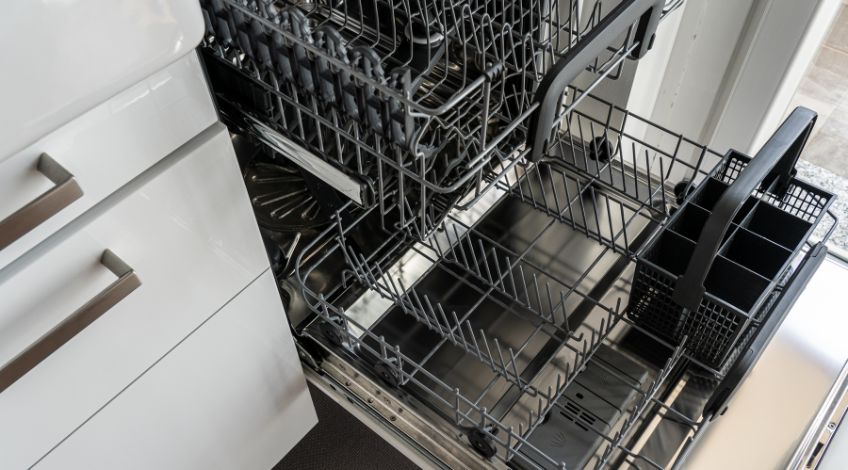
Dishwasher Not Filling With Water? (here’s why & what to do)
When you open the dishwasher door at the end of the cycle, all of your dishes are clean and dry and ready to be stored away in your cupboards until the next time they’re needed. But imagine that you did all of the above only to find that on opening the door, the dishes were just as dirty as they were when you put them in the dishwasher.
Added to which, the dishes were dry and there was no evidence of water in the dishwasher at all. If that’s the situation you find yourself in, keep reading.
In this article we look at all of the reasons why your dishwasher has failed to fill with water leaving you with a load of dirty dishes.
Why Is The Dishwasher Not Filling With Water?
If the dishwasher doesn’t fill with water there could be a few reasons, some are easy to fix while others will need a skilled technician. Let’s start with the easy fixes and work upwards from there.
| Probable Cause | Solution |
|---|---|
| No water supply | Check the water supply to your home and check the inlet tap is open |
| Twisted water inlet hose | Check and straighten the inlet hose |
| Incorrectly positioned drain hose | Adjust the drain hose to the correct height |
| Insufficient water pressure | Check the water pressure and contact your water authority if there’s a problem |
| Defective door switch | Check and replace the door switch if necessary |
| Clogged inlet water screens | Check and clear the inlet screens |
| Defective water inlet valve | Inspect and replace inlet valve if necessary |
| Clogged filter | Remove and clean the filter |
| Defective float switch | Check and replace float switch if necessary |
| Defective drain solenoid | Contact a technician |
| Defective timer | Contact a technician |
No Water Supply

At some point, the local water authority could shut off the water supply to your home. This is usually due to some essential maintenance work at their end.
You should have received some form of notification for this action, but maybe you missed the memo. Or (and this is more likely) the inlet tap on your dishwasher has been turned off accidentally.
To solve this you should first check that your home has water running through the cold tap in the kitchen. If this is the case, you should check the tap that supplies the dishwasher and ensure it is open.
Twisted Water Inlet Hose
All of the water that enters your dishwasher enters through the water inlet hose. If the inlet hose is twisted or kinked, it could be enough to prevent enough water from entering the appliance. This could prevent it from washing your dishes.
You will need to check the inlet hose and straighten out any twists or kinks.
Incorrectly Positioned Drain Hose

If the loop at the end of the drain hose is not positioned at least 20 inches (50 cm) above the floor it could cause the dishwasher to syphon water.
You will need to check the drain hose and attach it to the waste pipe ensuring there is a loop that is at least 50 cm (20 inches) above the ground level.
Insufficient Water Pressure
If the water pressure in your home is below 20 Psi (pounds per square inch) your dishwasher will not function. In some cases this could be the cause of the appliance not filling with water.
Dishwashers require a water pressure of between 20 to 120 Psi to function properly. You can check the water pressure in your home by filling a 1 gallon (4.5 litre) bucket with water from the cold tap in your kitchen.
If it takes 30 seconds or less to fill, the water pressure in your home is good enough for the correct operation of a dishwasher. If it takes longer than 30 seconds to fill the bucket, you will need to contact your water authority.
Defective Door Switch
Dishwashers have safety protocols that include the appliance will not start if the door is not closed. Once you have loaded your dishwasher and shut the door, a sensor sends a message to the control board that the door is closed and the control board then initiates the cleaning cycle.
If the door isn’t shut fully, that message doesn’t get sent and the dishwasher will not start to fill up with water. This is because without the door being sealed properly, your dishwasher could flood your home.
After a while, it’s possible for the door switch or sensor to develop a fault which would prevent the appliance from starting up or filling with water.
If the door latch or sensor is faulty, you can check it using a multimeter after first disconnecting the power supply and unscrewing the door’s inner panel. If you get a poor reading on the multimeter, you will need to replace the door switch.
Clogged Inlet Filter Screens
If the inlet screens on your dishwasher’s inlet valve are clogged with grit or limescale, the dishwasher will not fill with water. The clogged screen could be slowing the flow of water to a dribble or preventing any water from entering the appliance at all.
You will need to inspect the inlet filter screens, this can be done by removing the inlet hose. Take a pair of pliers and gently prise the filter screen from the inlet valve.
Inspect the screen for any debris and remove it by running the screen under fast flowing water. Then replace the screen, reattach the inlet hose and check the dishwasher is working properly again.
Defective Water Inlet Valve
The water inlet valve takes water into the appliance at the correct time to wash and rinse the dishes. If the inlet valve is faulty it won’t function properly.
The inlet valve could be split, cracked, leaking or simply not working. It will need to be checked and replaced if necessary. This is a job best left to a technician.
Clogged Filter

The filter on your dishwasher traps any debris or food particles and prevents them from dirtying your dishes after they’re cleaned. If the filter becomes clogged, it can restrict or prevent the flow of water which will effectively shut the dishwasher down.
Remove the filter by unscrewing it and lifting it from the bottom of the tub. Remove any food particles or debris by running the filter under a fast flowing tap.
Any stubborn stuck on bits can be removed using a toothbrush after soaking the filter in warm soapy water.
Defective Float Switch
The float switch shuts off the water supply once the water level reaches a certain predetermined point. This is a safety device designed to prevent any water leakage due to the appliance being overfilled with water.
If the float switch is defective, it can become stuck in the water full position which then cuts off the water supply to the appliance before it has even started.
To determine if the float switch is defective, you will need to inspect it. This involves disconnecting the power supply, and then finding the float switch assembly inside the dishwasher.
It is a dome shaped object on the floor of the dishwasher. You can check it simply by lifting the dome gently and listening. If you hear a click as you lift the float switch dome, it usually means it is working correctly.
If you don’t hear any sound it could be defective and need replacing. Which can be done by removing the kick plate at the bottom front of the appliance. Then undoing one screw the switch can be removed and replaced.
Defective Drain Solenoid/Valve
As the name suggests, the drain solenoid and valve are the parts of the dishwasher that are responsible for draining any excess water from the appliance. If the drain valve or solenoid is defective, it can cause the float switch to activate which then cuts off the water supply to the appliance.
This is another job best left to a technician as it involves dismantling the dishwasher.
Defective Timer
Your dishwasher could have an advanced control panel or a less sophisticated dial timer. Either way it could be the reason your dishwasher isn’t filling with water.
In some cases, the timer isn’t receiving enough power or maybe there’s a wiring fault. Newer models will probably have a LED display screen which will display an error code if there is a fault.
If you suspect the issue is caused by a defective timer, you will need to contact a technician to investigate further.
How Long Should A Dishwasher Last?

Just like all other appliances, dishwashers have an average timespan when they work at their optimum best. Once the dishwasher reaches the end of that timespan, it makes sense to replace it with a newer model.
Most dishwashers are expected to last for around 10 years. After this time it is recommended to buy a new model which is likely to be more efficient and cost less to run.
SEE ALSO: Whirlpool Dishwasher Fills With Water Then Stops? (here’s why & what to do)
Frequently Asked Questions
If your dishwasher has suddenly stopped filling with water it could be caused by a number of things. These include; no water supply, insufficient water pressure, twisted inlet hose, incorrectly positioned drain hose, a defective door switch, clogged inlet screens, a clogged filter, a defective float switch, a defective drain solenoid or a defective timer.
As the dishwasher drains, the water is sent out through the drain hose which is connected to the drain pipe. If the drain hose doesn’t have a loop that is at least 50 cm (20 inches) above the drain, it is possible for water to drain back into the appliance or the opposite can occur which is where water syphons straight out of the appliance.
The average life expectancy of a dishwasher is around 10 years.




